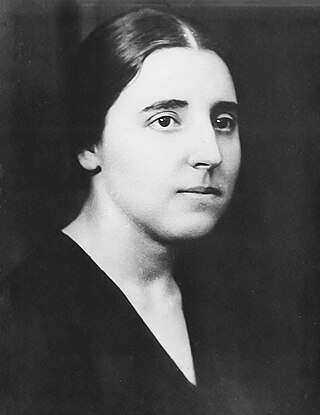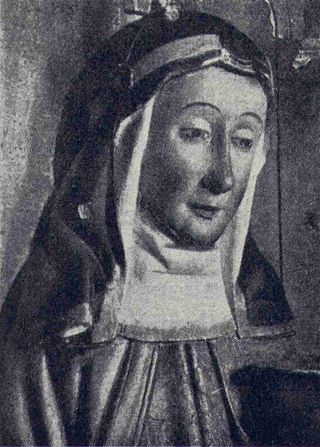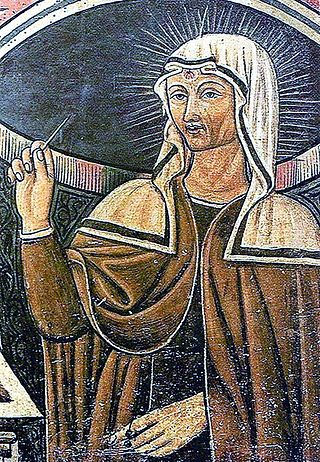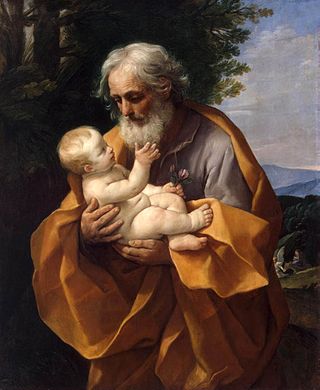
Clotilde, is a saint and was a Queen of the Franks.

According to apocrypha, as well as Christian and Islamic tradition, Saint Anne was the mother of Mary, the wife of Joachim and the maternal grandmother of Jesus. Mary's mother is not named in the Bible's canonical gospels. In writing, Anne's name and that of her husband Joachim come only from New Testament apocrypha, of which the Gospel of James seems to be the earliest that mentions them. The mother of Mary is mentioned but not named in the Quran.

Flavia Julia Helena, also known as Helena of Constantinople and in Christianity as Saint Helena, was an Augusta of the Roman Empire and mother of Emperor Constantine the Great. She was born in the lower classes traditionally in the city of Drepanon, Bithynia, in Asia Minor, which was renamed Helenopolis in her honor, although several locations have been proposed for her birthplace and origin.

Nadezhda Sergeyevna Alliluyeva was the second wife of Joseph Stalin. She was born in Baku to a friend of Stalin, a fellow revolutionary, and was raised in Saint Petersburg. Having known Stalin from a young age, she married him when she was 17, and they had two children. Alliluyeva worked as a secretary for Bolshevik leaders, including Vladimir Lenin and Stalin, before enrolling at the Industrial Academy in Moscow to study synthetic fibres and become an engineer. She had health issues, which had an adverse impact on her relationship with Stalin. She also suspected he was unfaithful, which led to frequent arguments with him. On several occasions, Alliluyeva reportedly contemplated leaving Stalin, and after an argument, she fatally shot herself early in the morning of 9 November 1932.

Catherine of Sweden, Katarina av Vadstena, Catherine of Vadstena or Katarina Ulfsdotter was a Swedish noblewoman. She is venerated as a saint in the Roman Catholic Church. Her father was Ulf Gudmarsson, Lord of Ulvåsa, and her mother was Saint Bridget of Sweden.

Rita of Cascia, OSA, was an Italian widow and Augustinian nun. After Rita's husband died, she joined a small community of nuns, who later became Augustinians, where she was known both for practicing mortification of the flesh and for the efficacy of her prayers. Various miracles are attributed to her intercession, and she is often portrayed with a bleeding wound on her forehead, which is understood to indicate a partial stigmata.

Dymphna is a Christian saint honoured in Catholic and Eastern Orthodox traditions. According to tradition, she lived in the 7th century and was martyred by her father.

Onuphrius lived as a hermit in the desert of Upper Egypt in the 4th or 5th centuries. He is venerated as Saint Onuphrius in both the Roman Catholic and Eastern Catholic churches, as Venerable Onuphrius in Eastern Orthodoxy, and as Saint Nofer the Anchorite in Oriental Orthodoxy.

Odo of Cluny was the second abbot of Cluny.

Gertrude of Nivelles, OSB was a seventh-century abbess who, with her mother Itta, founded the Abbey of Nivelles, now in Belgium. She is venerated in the Catholic and Eastern Orthodox traditions.

Hermann Joseph, was a German Premonstratensian canon regular and mystic. Never formally canonized, in 1958 his status as a saint of the Roman Catholic Church was formally recognized by Pope Pius XII.

Saint Cadoc or Cadog was a 5th–6th-century Abbot of Llancarfan, near Cowbridge in Glamorgan, Wales, a monastery famous from the era of the British church as a centre of learning, where Illtud spent the first period of his religious life under Cadoc's tutelage. Cadoc is credited with the establishment of many churches in Cornwall, Brittany, Dyfed and Scotland. He is known as Cattwg Ddoeth, "the Wise", and a large collection of his maxims and moral sayings were included in Volume III of the Myvyrian Archaiology. He is listed in the 2004 edition of the Roman Martyrology under 21 September. His Norman-era "Life" is a hagiography of importance to the case for the historicity of Arthur as one of seven saints' lives that mention Arthur independently of Geoffrey of Monmouth's Historia Regum Britanniae.

Rafqa Pietra Chobok, also known as Saint Rafka and Saint Rebecca, was a Lebanese Maronite nun who was canonized by Pope John Paul II on June 10, 2001.

Euphrosyne of Alexandria, also called Euphrosynē, was a saint who disguised herself as a male to enter a monastery and live, for 38 years, as an ascetic. Her feast day is celebrated on September 25 by the Greek Orthodox Church and Byzantine Rite Catholics, on September 27 by the Episcopal Church, and on January 16 by the Roman Catholic Church.

Saint Emmeram of Regensburg was a Christian bishop and a martyr born in Poitiers, Aquitaine. Having heard of idolatry in Bavaria, Emmeram travelled to Ratisbon (Regensburg) some time after the year 649 to the court of Theodo I, Duke of Bavaria. He supposedly travelled up the Loire, crossed through the Black Forest and then followed the Danube to Regensburg. Theodo welcomed Emmeram to his court, where he laboured for three years carrying out missionary work. During this time, he gained a reputation as a pious man. He died circa 652 and is buried in St. Emmeram's in Regensburg, Germany. His feast day in the Catholic Calendar of saints is September 22.
Hadewych, O.Praem., a.k.a. Hadewig or Hedwig, was abbess of the Premonstratensian monastery of Meer, in modern North Rhine-Westphalia, Germany.

Joseph was a 1st-century Jewish man of Nazareth who, according to the canonical Gospels, was married to Mary, the mother of Jesus, and was the legal father of Jesus.

Theodora of Alexandria was a saint and martyr who lived during the 5th century in Alexandria, during the reign of Emperor Zeno. Hagiographer Sabine Baring-Gould states that Theodora's story might have been embellished and that her biography was probably pieced together from the lives of other saints, such as Marina the Monk, another 5th century Byzantine saint who also lived as a male among monks, was accused of the same things as Theodora, and was vindicated after her death.
Hildegund was a Praemonstratensian abbess. Born to nobility, her father was Count Herman of Lidtberg and her mother Countess Hedwig. She was married to Count Lothair of Meer, in the modern region of North Rhine-Westphalia, Germany. Together they had three children, one of whom did not survive into adulthood.

Paul of Xeropotamou was a Byzantine ascetic, lived between the 9th and the 10th century on Mount Athos, where he also restored and founded monasteries. He is commemorated in the Orthodox Church and his feast day is on 28 July.


















